1. Project Introduction
Lista DAO is a liquidity staking and decentralized stablecoin (LSDFi) project based on the BNB chain, which aims to provide returns for pledged crypto assets (such as BNB, ETH, stablecoins, etc.) and support lending of decentralized stablecoin LISUSD (also known as decentralized stablecoin).
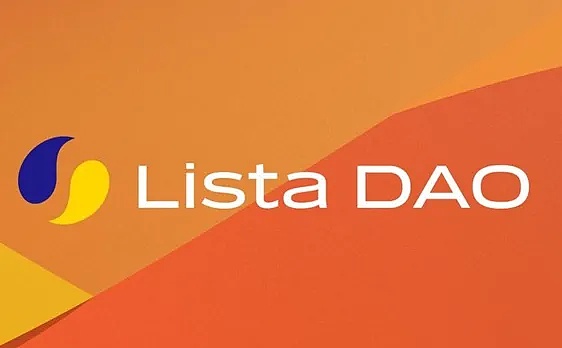
Formerly known as Helio Protocol, Binance Labs invested $10 million in Helio Protocol in August 2023, and then Helio Protocol merged with Synclub, a staking infrastructure and liquid staking provider on the BNB chain, to form Lista DAO.
Lista DAO aims to create a low-threshold DeFi protocol using innovative liquidity staking solutions. Its core vision is to explore various application scenarios such as stablecoin re-staking in the context of liquidity staking, starting with BNB, and ultimately establish a low-threshold LSDFi protocol on multiple chains.
The protocol is based on and extends the MakerDAO model, including the dual-token model LISUSD and LISTA, as well as a series of mechanisms that support instant conversion, asset collateralization, lending, yield farming and other functions.
2. Core Mechanism
2.1 Stablecoin Lending Mechanism
One of Lista DAO’s core products is stablecoin lending service, which is mainly achieved through the over-collateralization model.
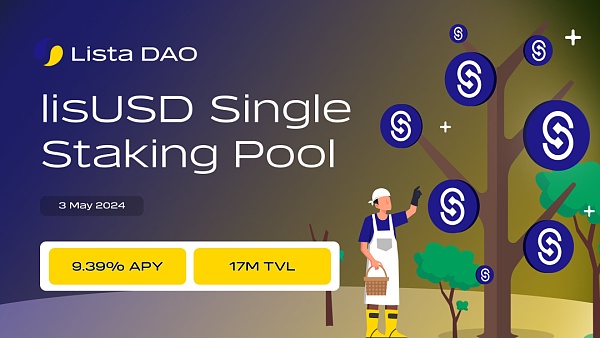
2.1.1 Operation Mechanism
1. Overcollateralization Model
Lista DAO uses an overcollateralization model to ensure the stability and security of the system. Users can pledge crypto assets such as ETH, BNB, sLISBNB, etc. to borrow decentralized stablecoin LISUSD. The value of the collateral must be higher than the value of the borrowed stablecoin. This mechanism can effectively reduce the risk of loan default.
For example, a user who pledges $100 worth of BNB may only be able to borrow $70 worth of LISUSD to ensure that the system has enough buffer to cope with market fluctuations.
2. Decentralized Stablecoin LISUSD
LISUSD is Lista DAO's decentralized stablecoin, using decentralized liquid pledge crypto assets as collateral. Unlike traditional stablecoins, LISUSD does not rely entirely on an absolute price peg to a fiat currency, but allows a certain amount of price fluctuation to better reflect the actual market situation.
LISUSD is designed to provide a relatively stable value storage and transaction medium while maintaining decentralization.
3. Types and innovations of collateral assets
Lista DAO not only supports traditional crypto assets such as ETH and BNB, but also launched an Innovation Zone, allowing users to pledge innovative liquid pledge assets such as WEETH of Etherfi and STONE of Stakestone. This provides users with more collateral options and enhances the flexibility and capital efficiency of the system.
2.2 Liquidity Staking
Another core product of Lista DAO is liquidity staking, through which users can pledge crypto assets and obtain corresponding liquidity tokens to improve the efficiency of fund use.
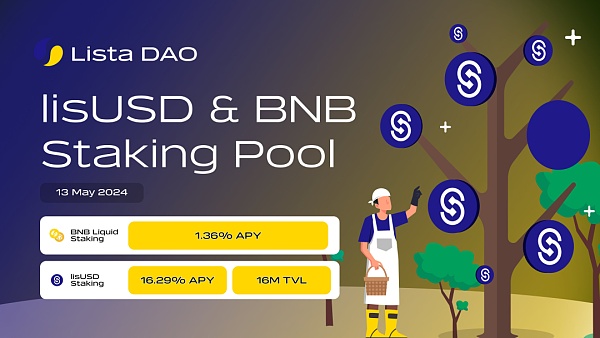
2.2.1 Operation Mechanism
1. Liquid Staking
Users can stake BNB and other crypto assets to obtain liquidity staking certificates (such as sLISBNB). These certificates can not only be used within the Lista DAO platform, but can also be used for lending, providing liquidity, and other operations on other DeFi platforms, while still receiving staking rewards.
Liquidity staking separates the income and liquidity of the pledged assets, allowing users to flexibly use these assets for other DeFi activities while enjoying the staking income.
2. Generation and use of sLISBNB
Staking BNB to generate sLISBNB: When users stake BNB to the liquidity staking contract of Lista DAO, sLISBNB corresponding to the amount of staked BNB will be generated.
Using sLISBNB: Users can use sLISBNB to perform operations such as lending and providing liquidity on various DeFi platforms, while still obtaining the income from BNB staking. The application scenarios of sLISBNB on different platforms include providing liquidity, lending, and yield farming.
3. Revenue and Fees
Staking Revenue: After users stake BNB, they will receive staking revenue from the BNB network. These revenues will be distributed to users holding sLISBNB in proportion.
Fee Structure: Lista DAO may charge certain management fees or transaction fees, which are used to maintain the operation and development of the platform. The specific fee structure will be detailed in the agreement document.
4. Mortgage and Borrowing
Over-collateralized borrowing: Users can use sLISBNB as collateral to borrow decentralized stablecoin LISUSD. This method not only increases the liquidity of user assets, but also allows users to obtain more funds for investment or other operations through borrowing.
Borrowing interest: Users who borrow LISUSD need to pay a certain amount of borrowing interest, which is currently 0%. Users can repay the loan and retrieve the pledged sLISBNB at any time.
2.3 Innovative Collateral
In order to provide more flexible and diversified collateral options, Lista DAO introduced Innovative Collateral (Innovation Zone), allowing users to use a variety of new types of liquid pledge assets as collateral to increase the flexibility and capital efficiency of the system.
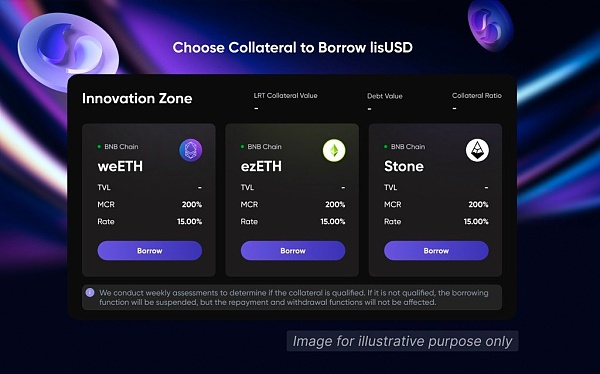
2.3.1 Operation Mechanism
1. Innovation Zone
Purpose: The establishment of the Innovation Zone aims to include eligible Liquid Staking Tokens (LST) and Liquidity Re-staking Tokens (LRT) as collateral options, providing users with more choices and improving liquidity and capital utilization efficiency.
Collateral Types: In addition to traditional crypto assets such as ETH and BNB, the Innovation Zone also supports innovative liquid pledge assets such as Etherfi's WEETH, Stakestone's STONE, and Renzo's EZETH.
Collateral Risk and Ratio: The collateral in the Innovation Zone has a higher risk factor than traditional collateral, and the collateral ratio is also higher accordingly. The Lista DAO project will evaluate these collaterals every week to determine whether they are eligible for collateral.
2. Specific Collateral Types
Etherfi's WEETH: WEETH is a liquid pledge token based on Ethereum. Users can pledge ETH and get WEETH. WEETH can be used as collateral on Lista DAO to borrow LISUSD.
Stakestone's STONE: STONE is an innovative liquid pledge token. Users can obtain STONE after staking specific crypto assets. STONE can be used for pledge and lending operations on Lista DAO.
Renzo's EZETH: EZETH is another innovative liquid pledge token that supports pledge and liquidity management of multiple crypto assets. EZETH can be used as collateral on Lista DAO to increase users' asset flexibility.
3. Lending and liquidity management
Users can use these innovative collaterals to borrow decentralized stablecoin LISUSD. By using these liquid staking tokens as collateral, users can not only obtain liquidity, but also participate in other DeFi operations such as yield farming and liquidity provision.
This mechanism effectively improves the capital utilization efficiency of users, allowing users to manage and use their crypto assets more flexibly.
4. Yield and Fee Structure
Staking Yield: Users can obtain corresponding staking income by staking innovative collateral. These income will be distributed according to different collateral types and market conditions.
Borrowing Fees: Users need to pay certain borrowing interest and fees when borrowing LISUSD, which are used to maintain the operation and development of the platform. The specific fee structure is detailed in the protocol's documentation.
3. Token Economics
3.1 LISUSD
Definition: LISUSD is a decentralized, unbiased, collateralized stablecoin soft-pegged to the US dollar. Users can borrow LISUSD by pledging assets on the Lista platform. LISUSD is generated and stabilized by collateral assets deposited in the Lista Collateral Vault (CEVault).
Liquidity: Users can borrow LISUSD by depositing collateral assets into Lista’s CEVault, which is the primary way LISUSD enters circulation. Others can purchase LISUSD through brokers or exchanges, or acquire LISUSD by providing liquidity on decentralized exchanges (DEX). LISUSD can be used like any other cryptocurrency for payments, transfers, and purchases of goods and services.
3.2 LISTA
Definition: LISTA is the native crypto protocol token of Lista DAO, which is transferable and versatile. LISTA token is designed as an interoperable utility token, primarily used for decentralized payments and settlements between participants within Lista DAO.
Functionality:
Governance: LISTA token holders can propose governance proposals and vote on future features, upgrades and parameters of Lista DAO (such as revenue pool allocation for ecosystem development and growth, addition of new vaults, protocol parameters and fee levels, etc.).
Incentive Mechanism: LISTA token is used to incentivize users to participate and contribute in the Lista DAO ecosystem, and to be rewarded for activities such as deposits, staking, trading and governance.
Liquidity: LISTA tokens can be exchanged on decentralized exchanges or put into yield farm pools, through which users can maximize their capital efficiency, obtain borrowing and compound income.
Supply and circulation:
Maximum supply of tokens: 1,000,000,000 LISTA;
Initial circulation: 230,000,000 LISTA (23% of the maximum supply of tokens);
Total Megadrop: 100,000,000 LISTA (10% of the maximum supply of tokens)
Currently, the over-the-counter quotation of LISTA tokens is 0.8USDT.
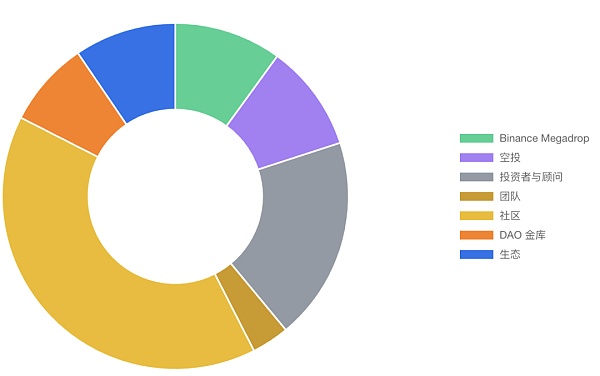
Specific distribution ratio
Binance Megadrop: 100 million, accounting for 10% of the total supply.
Airdrop: 10% of the total supply.
Investors and advisors: 19% of the total supply.
Team: 35% of the total supply.
Community: 40% of the total supply.
DAO Treasury: 8% of the total supply.
Ecosystem: 9.5% of the total supply.
3.3 Token Issuance and Use
1. Issuance
The issuance of LISUSD and LISTA tokens is mainly obtained through users' mortgage and lending operations, as well as activities and contributions within the ecosystem. The purpose of issuing tokens is to raise funds for project development, increase market brand awareness, and community building and social participation.
2. Purpose
LISUSD: As a decentralized stablecoin, LISUSD can be used for various payments, transfers, and purchases of goods and services. It can also provide liquidity and lend in DeFi operations.
LISTA: Mainly used for payments and settlements within the ecosystem, governance voting, and incentivizing user participation and contribution. LISTA does not represent any shares, ownership or participation rights, and does not promise any fees, dividends, income, profits or investment returns.
3.4 Economic Incentives and Liquidity Management
1. Economic Incentives
Participation Incentives: Users can receive LISTA token rewards by performing activities such as deposits, staking, trading, and governance on Lista DAO. This mechanism ensures that users can receive fair rewards while participating in the ecosystem.
Governance Participation: LISTA token holders can participate in the management and decision-making of the protocol by proposing and voting on governance proposals. This decentralized governance mechanism enhances the transparency and participation of the ecosystem.
2. Liquidity Management
Market Pricing: The secondary market pricing of LISTA tokens is not controlled by Lista DAO, and there is no mechanism or scheme designed to control or manipulate the secondary market price. Users are free to choose to exchange LISTA tokens on decentralized exchanges to maximize their capital efficiency.
Fund Management: Through the liquidity pool of decentralized exchanges, users can provide liquidity and earn transaction fees and rewards. This mechanism not only enhances the liquidity of LISTA tokens, but also improves the capital utilization efficiency of the entire ecosystem.
4. Borrowing process
1. Provide collateral
Users first need to provide collateral on the Lista DAO platform, which can be crypto assets such as BNB, ETH, sLISBNB, etc. The type and value of the collateral will affect the amount of LISUSD that users can borrow.
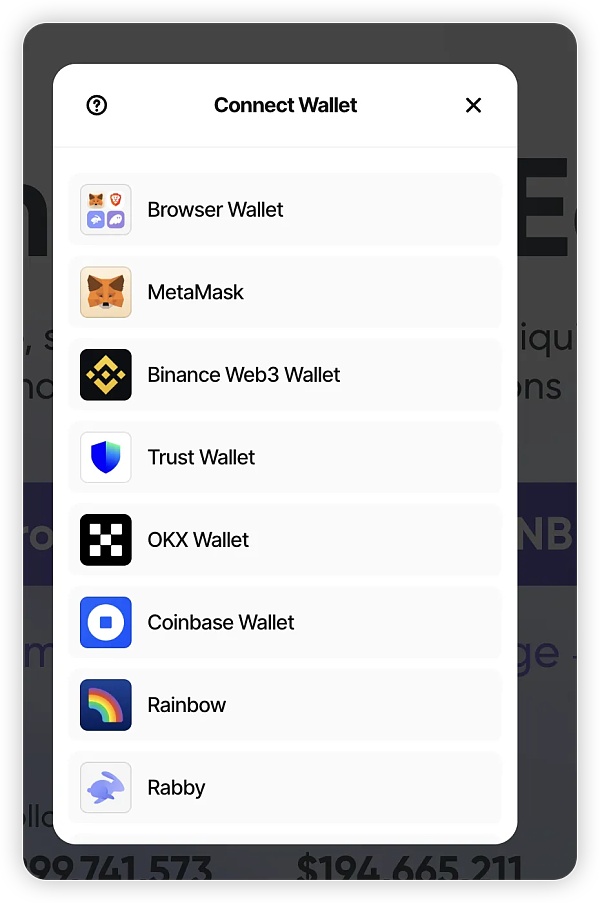
For example, if a user pledges $100 worth of BNB to the platform, the system will determine the maximum amount of LISUSD that the user can borrow based on the collateral ratio (e.g. 70%).
2. Generate LISUSD
After the user provides collateral, he can borrow the corresponding amount of LISUSD based on the value of the collateral. LISUSD is Lista DAO's platform stablecoin, soft-pegged to the US dollar.
The generation process of LISUSD is based on the collateral provided by the user to ensure the security and stability of lending.
3. Borrowing LISUSD
After providing sufficient collateral, users can borrow LISUSD through the platform. Borrowed LISUSD can be used for various DeFi operations, such as payment, transfer, purchase of goods and services, or investment and yield farming on other DeFi platforms.
There will be a certain amount of borrowing interest during the borrowing process, and the current borrowing interest rate is 0%. This low interest rate will help attract more users to participate in the platform's lending operations.
4. Repaying the loan
Users can repay the borrowed LISUSD and the corresponding borrowing interest at any time. Once the loan is repaid, the user can retrieve their collateralized assets.
The process of repaying the loan is also very simple. Users only need to return the borrowed LISUSD and interest to the platform.
5. Retrieve Collateral
When the user fully repays the loan, the collateralized assets can be retrieved. These assets can continue to be used for other DeFi operations or re-pledged to borrow more LISUSD.
6. Liquidation Mechanism
If the user fails to repay the loan on time and the value of the collateral drops to a certain level, the system will trigger the liquidation mechanism. Part or all of the collateral will be sold to repay the loan to ensure the stability and security of the system.
The liquidation price and liquidation ratio will be adjusted according to market conditions and protocol parameters. This mechanism effectively reduces the risk of loan defaults and protects the interests of the platform and other users.
5. Binance Megadrop Guide
On May 23, Binance announced the deployment of Lista (LISTA token) on Binance Megadrop, where users can stake BNB and complete Web3 tasks to earn rewards.
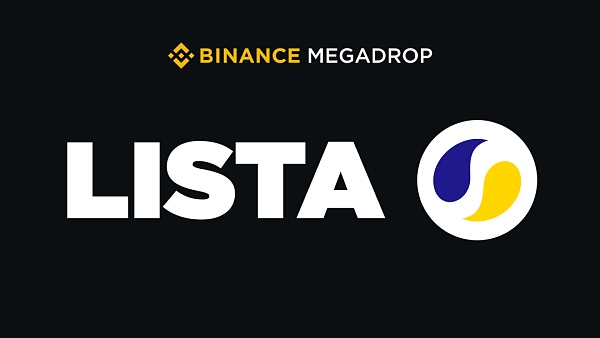
Megadrop is a new token issuance platform launched by Binance that allows users to access and receive airdrops of promising projects as early as possible. Projects launched on Megadrop are guaranteed to be listed on the Binance exchange.
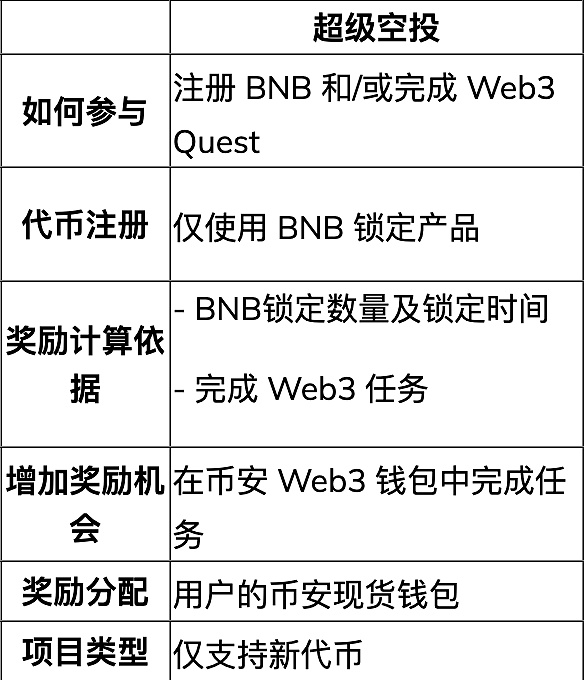
Token rewards are distributed based on the total points earned by the user. The total points depend on the BNB locked points, Web3 Quest coefficient, and the Web3 Quest rewards. The formula is as follows:
Total points = (BNB locked points x Web3 task coefficient) + Web3 task rewards
BNB locked points
Points are calculated based on the number of locked BNB and the lock-up time. The longer the time, the higher the points. Binance calculates points based on the daily average locked amount snapshot (points may change due to lock-up fluctuations).
BNB lock-up points have four fixed coefficients: 30 days, 60 days, 90 days, and 120 days:
If the lock-up time is less than 59 days, the points will be increased by a multiple of 30 days
If the lock-up time is less than 90 days, the points will be increased by a multiple of 60 days
If the lock-up time is between 90 days and less than 120 days, the points will be increased by a multiple of 90 days
If the lock-up time is 120 days or more, the points will be increased by a multiple of "120 days"
Megadrop Participation Guide
To participate in Megadrop, users need to lock BNB in Binance Simple Earn tokens and/or complete Web3 Quest tasks in the Binance Web3 wallet. Rewards for eligible users are calculated based on the ratio of individual points divided by the total points of all users.
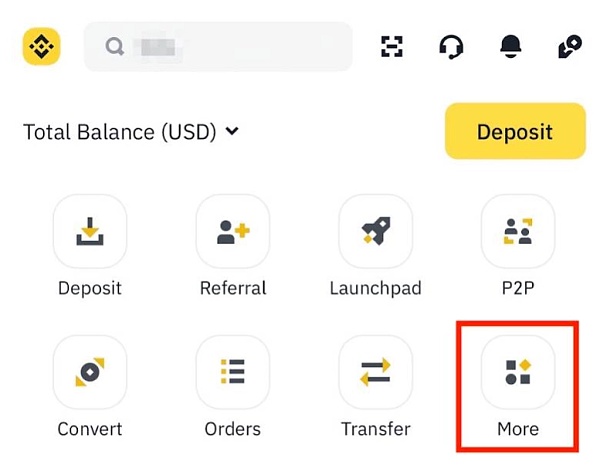
Browse the list of launched Web3 projects and select the one you want to participate in.
Once on the detail page, read the project requirements and rules carefully.
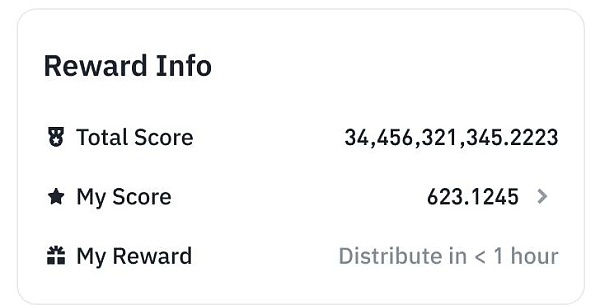
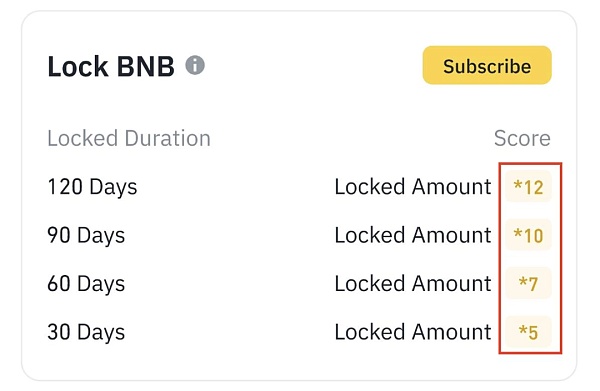
6. Team/Financing
Lista DAO's success is inseparable from a strong team with a deep background. The core team members have rich experience and achievements in blockchain technology, financial technology, and operational management, providing a solid foundation and guarantee for the development of the project.
Toru Watanabe is the founder and CEO of Lista DAO, responsible for the overall strategic planning and execution of the project. As the founder, he has extensive experience in blockchain technology and project management, and leads the team to promote the development of Lista DAO.
Co-founder and Chief Operating Officer (COO) Terry Huang has served as a regional manager at Binance and strategic director of ChainNews. He has extensive experience in the blockchain field and is good at operations management and marketing.
Both Toru Watanabe and Terry Huang have experience working at Binance, which gives them a deep understanding and practical experience in the cryptocurrency market and blockchain technology. As the world's leading cryptocurrency exchange, Binance provides them with rich industry resources and connections.
Binance Labs invests $10 million in Lista DAO (formerly Helio Protocol) to help it transform into a liquidity staking platform. The funds will be used to build infrastructure on the BNB chain and expand to other networks such as Ethereum, Arbitrum and zkSync. Helio Protocol is the issuer of the over-collateralized stablecoin HAY, and merged with the staking provider Synclub in July 2023 to establish a new foundation to manage the revenue streams of Synclub and Helio. The funds will accelerate technology research and development and platform upgrades, especially in the fields of liquidity staking and decentralized finance. The investment will also be used for marketing and user education to enhance Lista DAO's global visibility. Through cooperation with Synclub, Lista DAO will further enhance its technical strength and market position, and is expected to become an important player in the field of decentralized finance in the future.
7. Project Evaluation
7.1 Track Analysis
Lista DAO belongs to the decentralized finance (DeFi) track, specifically involving the following sub-fields:
1. Liquid Staking
Liquidity staking allows users to stake crypto assets (such as BNB, ETH) and obtain liquidity certificates (such as sLISBNB), which can be used for lending, providing liquidity and other operations in the DeFi ecosystem, while users can still receive staking rewards.
This technology improves the liquidity and capital utilization efficiency of user assets and is an important innovation in the DeFi field.
2. Decentralized Stablecoin
Lista DAO provides a decentralized stablecoin LISUSD, which users can borrow by pledging crypto assets. LISUSD is designed to maintain price stability, similar to MakerDAO's DAI.
Decentralized stablecoins provide users with safer and more transparent financial tools and reduce dependence on traditional financial systems.
3. Overcollateralized Borrowing
Users can borrow stablecoin LISUSD by pledging a certain amount of crypto assets. This overcollateralization model ensures the stability and security of the system and prevents the risk of loan default.
This mechanism is widely used in the DeFi ecosystem and is the core function of many decentralized lending platforms.
In the DeFi track, there are several projects similar to Lista DAO in the fields of liquidity staking, decentralized stablecoins, and over-collateralized lending:
1. Lido Finance
Field: Liquidity staking
Introduction: Lido is the largest liquidity staking platform on Ethereum. Users can stake ETH and obtain stETH, which can be used on the DeFi platform, while users can still receive ETH staking rewards.
Similarities: Both Lido and Lista DAO provide liquidity staking services to improve the liquidity and utilization of user assets.
2. MakerDAO
Field: Decentralized stablecoin
Introduction: MakerDAO is the issuer of the decentralized stablecoin DAI. Users can generate DAI by mortgaging crypto assets such as ETH. The price of DAI is soft-pegged to the US dollar.
Similarities: Lista DAO's LISUSD is similar to DAI. Both are decentralized stablecoins generated through over-collateralization, aiming to provide price-stable crypto assets.
3. Aave
Field: Lending
Introduction: Aave is a decentralized lending platform where users can lend or borrow various crypto assets. Aave provides over-collateralized lending services to ensure the security and stability of the system.
Similarities: The over-collateralized lending service provided by Lista DAO is similar to Aave. Users can borrow stablecoins by pledging crypto assets and obtain flexible funding plans.
7.2 Project Performance
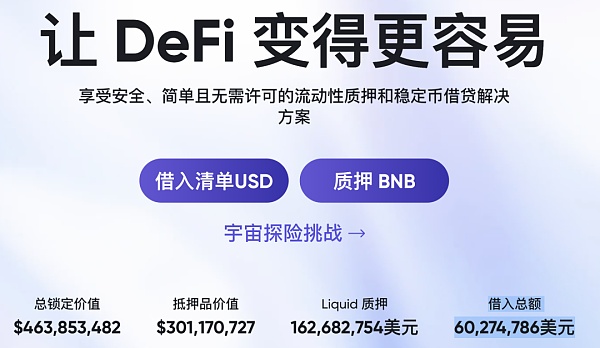
As of May 24, Lista DAO has a total locked value of US$463,853,482, a collateral value of US$301,170,727, a Liquid pledge of US$162,682,754, and a total borrowing amount of US$60,274,786.
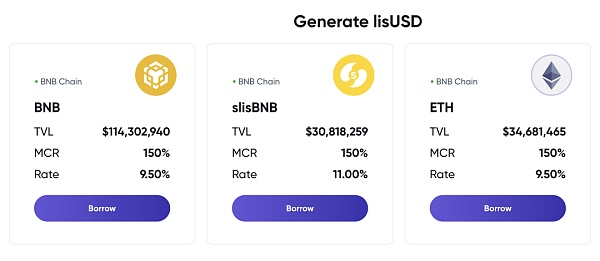
The Lista DAO project has performed well in liquidity staking and decentralized lending. The total locked value (TVL) of BNB, sLISBNB and ETH is $114,302,940, $30,818,259 and $34,681,465 respectively, showing the high demand of users for staking these assets. The minimum collateral ratio (MCR) is 150% in both cases, ensuring the stability and security of the system. The lending rates are 9.50% and 11.00% respectively, providing flexible funding options.
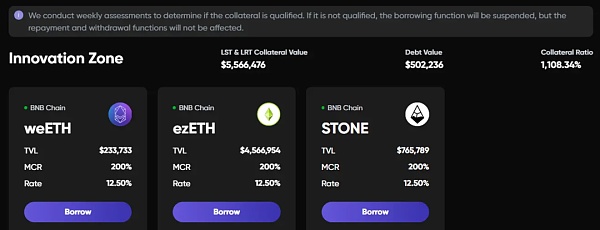
ListaDAO Innovation Zone supports pledging Ether.fi's weETH, StakeStone's STONE and Renzo's ezETH to borrow stablecoin lisUSD. As of May 23, the value of the pledged assets in ListaDAO Innovation Zone was approximately US$5.56 million.
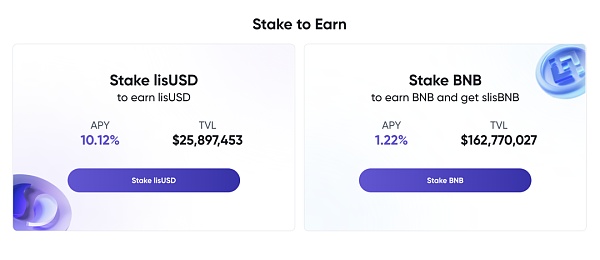
7.3 Project Advantages
1. Decentralization and Security
Lista DAO's lending mechanism is completely decentralized, and users can fully control their assets, ensuring the security and transparency of the system.
The over-collateralization model further ensures the stability and security of the system and effectively prevents the risk of loan default.
2. Flexibility and efficiency
Users can flexibly choose the type and amount of collateral and adjust it according to their own needs and market conditions. The lending process is simple and efficient, and users can borrow and repay LISUSD at any time.
Through liquidity staking, users can flexibly use these assets for other DeFi operations while enjoying staking income, thereby improving the efficiency of capital utilization.
3. Low interest rates and diversified income
Low lending rates help attract more users to participate in the platform's lending operations. Users can obtain more funds for investment or other operations through lending, thereby increasing overall returns.
Diversified income channels enable users to obtain stable returns under different market conditions.
4. Reduce staking risks
By separating staking income from liquidity, users do not have to release the pledge when they need funds, reducing the risk caused by market fluctuations.
The liquidity staking mechanism ensures that users can flexibly use their assets at any time while still enjoying the benefits of staking.
7.4 Challenges and Future Outlook
1. Market Volatility Risk
Despite the over-collateralization and liquidation mechanisms, the high volatility of the crypto market may still pose risks to users' assets and the stability of the platform. Users need to pay close attention to market dynamics and manage risks.
Lista DAO needs to continuously optimize the risk management mechanism to ensure the stability and security of the system.
2. User education and adoption
The lending mechanism is relatively complex and requires users to have certain DeFi knowledge and experience. Lista DAO needs to strengthen user education to help users understand and use the lending function of the platform.
Increasing user adoption is the key to the success of the project, and it needs to be promoted and publicized through multiple channels and activities.
3. Multi-chain expansion plan
Lista DAO plans to expand the lending function to multiple blockchains such as Ethereum, providing users with more diverse choices and a wider range of application scenarios.
Multi-chain expansion will further enhance Lista DAO's ecosystem and enable it to occupy a more important position in the field of decentralized finance.
8. Conclusion
In summary, the Lista DAO project has demonstrated strong potential and steady growth in the field of decentralized finance (DeFi). By providing a variety of staking and lending options, including BNB, sLISBNB and ETH, Lista DAO provides users with high liquidity and flexible capital utilization solutions, with a total locked value (TVL) of more than $179 million, demonstrating users' high trust in the platform. The stable minimum collateral ratio (MCR) and competitive lending rates further enhance the security and attractiveness of the system. The introduction of new assets such as weETH, ezETH and STONE further demonstrates its innovation ability and market adaptability. In short, Lista DAO is gradually establishing its leadership in the DeFi market through high-quality services and continuous innovation, and the future is promising.
 Sanya
Sanya























